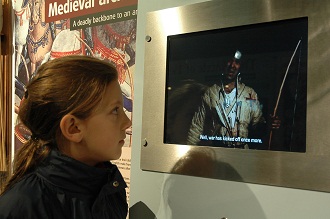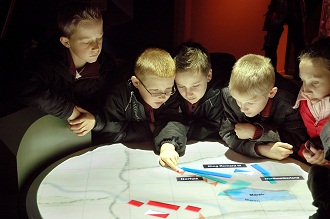
The Battle of Bosworth, fought on 22nd August 1485 in rural south west Leicestershire, saw the death of King Richard III and the victory of Henry Tudor, heralding a new and prosperous age for England. For this reason Bosworth is among the most important battles in English history and, thanks in part to William Shakespeare, it is also one of the most famous.
In 1974 Leicestershire County Council, established a visitor centre at Ambion Hill Farm, Sutton Cheney, to commemorate the battle and to tell the story of the day on the very site where it was thought to have been fought.
Bosworth Battlefield Heritage Centre is one of five museums run by Leicestershire County Council with a Record Office and a Collections Resource Centre in addition. The County Council also offer curatorial support of a number of independent museums around Leicestershire.
The location of the Heritage Centre was based on the work of antiquarians writing at the turn of the 18th and 19th centuries, and corroborated by various historians until 1973. However, in 1985 new research suggested that the battle may have taken place two kilometres from Ambion Hill, while another, in 2002, suggested it was nine kilometres to the west. Despite the importance of Bosworth, contemporary accounts of the battle are few and often contradictory. None give useful clues to the exact location of the battlefield.
In 2004 Leicestershire County Council applied for a Heritage Lottery Fund grant of just under one million pounds to undertake a landscape survey to determine the true location of the battle and to redisplay and modernise the exhibition, giving a balanced view of the controversy around the location.
Edinburgh-based company Studio MB was commissioned to design the new exhibition, maximising the available space to contain as much content as possible. They worked very closely with the County Council staff to create an exhibition that would be interactive, immersive, emotional, educational and fun. Using customer feedback we decided to use a blend of electronic and traditional interactives, graphic panels and a range of replica objects to tell the story of the build up to the battle, what happened on the day, and what impact it had on England. The last gallery, the Bosworth Field Investigation Lab, presents the various theories of where the battle was fought, and to introduce the techniques employed in the survey to find the battlefield.

Our interpretation was designed to ensure that all ages and abilities would be engaged. A series of ls"talking head' units were installed to give a human link to the events of 500 years ago and are a good vehicle for telling the story without having to read lots of text. Characters chosen include a cross section of the people involved on the day, including the wife of a French mercenary fighting for Henry Tudor, and a barber surgeon dealing with the gruesome reality of war.
Manual interactives cover such themes as the longbow, communications and medieval food, while the battle itself is depicted through a narrated film using re-enactment footage tied in with an animated map.
In February 2008 the new exhibition, with nine rooms of interpretation, a new shop and a free entry temporary exhibition room, was opened and by mid 2009 the Bosworth Battlefield Survey had produced a scatter of cannon balls and other medieval artefacts from the battle, very close to the site suggested in 1985.
Since the battlefield has been found we have updated the Bosworth Field Investigation Lab. Environmentally controlled cases show the artefacts that have been found in the survey so far, including the largest group of cannon balls from any medieval European battlefield, fragments of personal and military equipment and a silver gilt boar badge - the personal emblem of Richard III, which was found close to an area of medieval marsh. According to some accounts, including Shakespeare's, Richard's horse was stuck in a marsh just before the King's death, which makes this find very significant for locating the last stage of the battle.
The exhibition is supported by a wide range of medieval themed activities within the Battlefield Heritage Centre, which combine to make an excellent day out for families, schools parties and special interest groups alike.